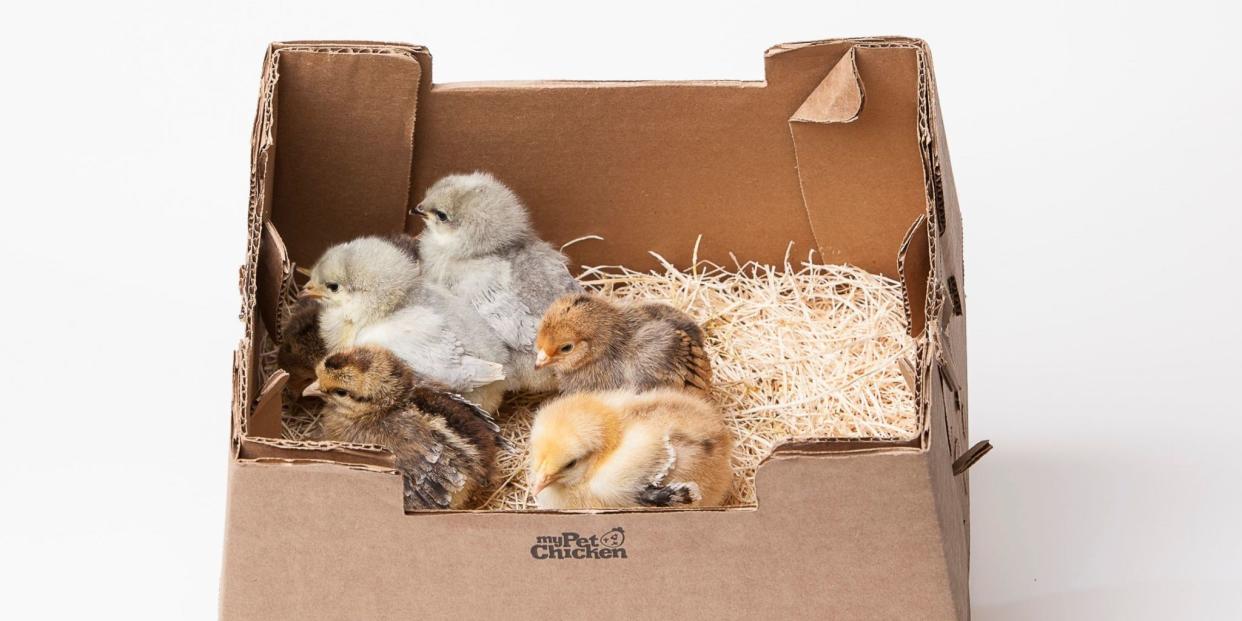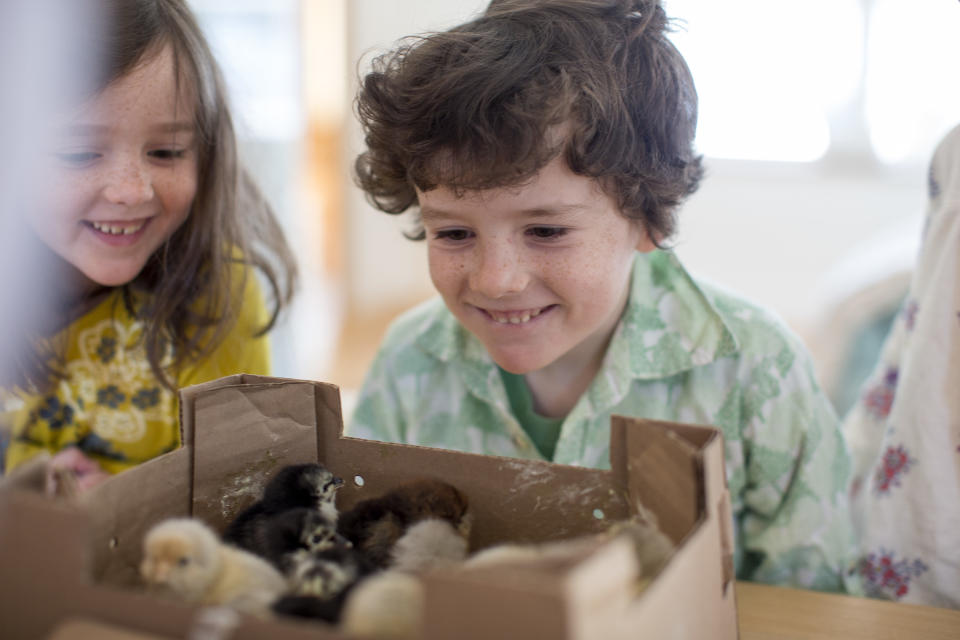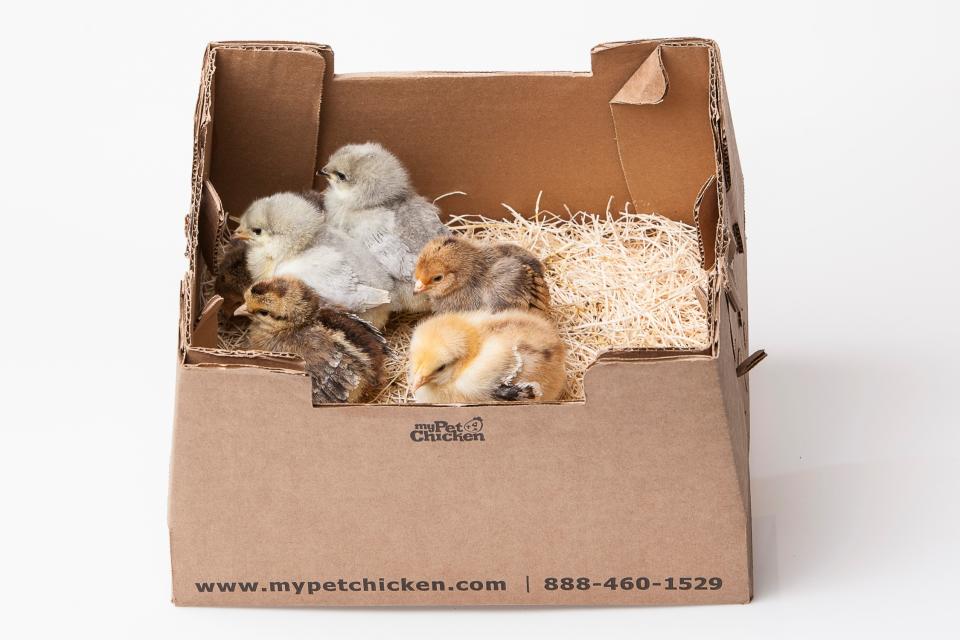The Truth Behind the Journey of Mail-Order Baby Chicks

When Sheila and David Hendrickson ordered a few dozen chicks through a mail-order poultry catalog, they weren't sure what to expect. They prepared their backyard chicken coop, and knew the date the chicks were scheduled to arrive at their local post office in Benton, Kentucky. When the day came, they called to check the status of their order.
The postal workers knew why they were calling as soon as they picked up the phone. "They said, 'Yes the chicks are here and would you please come and get them?'" Sheila says. "'They're chirping so loud!'"
Sheila and David's noisy delivery represents a tiny fraction of the millions of chicks that are delivered through the U.S. mail system every year. And shipping those chicks across the country is a feat of timing, cleverly engineered cardboard, and a network of humans working together to get the tiny birds to their destinations safely. It's an incredible journey, yes, but it's also an adorable one, especially once the baby chicks get to their new homes.
You might assume that safely shipping tiny chicks thousands of miles across the country is a miracle of modern technology. But chicks have been a staple of springtime mail deliveries for nearly a century. Specifically, since March 13, 1918, when Postmaster General A.S. Burleson opened the door to the mail-order chick business with the following announcement:
"Live day-old chicks shall be accepted for mailing, without insurance or C.O.D privileges, when the package in which they are contained is properly prepared and can be delivered to the addressee within 72 hours from the time of mailing."
One of today's most popular mail-order chick companies, Murray McMurray, has been around since 1917. The Iowa-based hatchery sells more than two million chicks a year, doing 99 percent of its business through its mail-order catalog. The hatchery's eponymous founder, a banker, was a poultry hobbyist who got his start selling chicks out of the back door of the bank. When postal regulations changed and chicks became shippable, McMurray realized he could expand his business far beyond the bank customers of Webster City.
"He used to box up the chicks and take them down to the train station and put them on the mail car," says the company's current president, Lucien "Bud" Wood. As the economy collapsed, poultry turned out to be a wise investment. "The bank failed in 1925, and he decided to make a full-time job out of the hatchery. In the '60s, the company switched to airmail and we still ship airmail today."
From Hatching to Shipping
"Our most common question is, 'How do you safely ship chicks?'" says Meghan Howard, e-commerce coordinator at Meyer Hatchery in Polk, Ohio, which fulfills nearly 2,000 chick orders a week during the busy spring season.
The answer requires a quick lesson in chick anatomy. While a chick is incubating within the egg, it feeds on the nutrient-dense yolk inside. "As part of the hatching process, the baby chick ingests the bit of reserve yolk that is left," Howard explains. "This is a natural survival feature that ensures the baby has enough energy to be sustained for several days before finding food." That's why there's a 72-hour window for shipping chicks; as long as they're mailed immediately after they're born, they can survive the journey without needing food or water.
This natural energy source makes it simpler to transport them, explains Sue Brennan, spokesperson for the United States Postal Service. "Placing food and water inside the hatchery box could jeopardize the integrity of the box and could endanger the health and safety of the animals inside," she says. "We want to give each chick the best chance at reaching their new home safely."
Chicks on the Road (or in the Air)

The U.S. Postal Service is still the only mail service that allows live chicks to be shipped. Fun fact: they also allow day-old ducks, emus, geese, guinea fowl, partridges, pheasants, quail, and turkeys. Hatcheries work closely with customers and the USPS to coordinate chick deliveries, ensuring they arrive within a 72-hour window and that the customer is available to pick them up at a designated arrival time. Since hatcheries ship to every corner of the country, airmail is almost always used to ship the chicks out from the major hub nearest the hatchery to an airport closer to the customer's home. The chicks finish their journey via ground transportation to the local post office branch, where they serenade postal workers with excited chirps until their owners arrive to take them home.
While exact statistics aren't available, the vast majority of mail-order chicks do reach their destinations safely. Out of the millions of chicks shipped each year, Murray McMurray estimates its mortality rate to be less than 1 percent, which isn't much higher than if the chicks never left the hatchery.

The chicks make their journey in cardboard boxes that look deceptively simple, but they're specially designed, with details honed carefully over the years to best protect their precious cargo. "The sides of our boxes are slanted so there's always an air space around them," says Wood. "Inside is a straw pad, which is critical because it's what the chicks hold onto. The number of chicks you have in the box is important, too-if you have too few chicks in the box they can get jostled, so we have different size boxes for different size orders."
The boxes need to maintain an ideal temperature throughout shifts in climate and modes of transportation. "Baby chicks love hot, humid environments," says Brennan of the USPS. "They thrive in temperatures between 99-102°F with 50-60 percent humidity." To stay in this range, hatcheries modify their packaging according to the season, lining the boxes with extra cardboard or straw to keep them warm in early spring, or creating extra air holes to keep them cool in summer months.
These days, hatcheries are able to hatch and ship chicks year-round, but the busiest time of year is always February through May. It takes 16 to 20 weeks for a chick to reach egg-laying age, and as temperatures start to rise in the spring, young chickens don't need as much supplemental heat to grow and produce eggs through the summer and fall. The rush of orders in the spring has some sentimental value, too, since chicks have long been considered a symbol of fertility and new life. As chicks have become associated with the Easter holiday, opening a box of fluffy, newborn chicks in mid-April just feels right.
It Takes a Village
By the time mail-order chicks arrive at the local post office branch where their new owners will pick them up, Brennan estimates that five different postal employees have helped the chicks get there, from pilots to delivery drivers to dock dispatchers. It's a team effort with a rewarding payoff at the last stop: getting to watch customers come in and pick up their chirping boxes.
"We sat beside the phone all morning waiting for the call to go pick them up at the post office," says Kaitlin Saul, a stay-at-home mom in Virginia who started a backyard flock of chickens two years ago. "It was so fun with my kids. All the chicks were healthy and sweet as pie. The anticipation of waiting for them to arrive at the post office is almost unbearable though. It's kind of like Christmas morning."
Chicks are shipped to every state (yes, even Alaska and Hawaii!), and the vast majority are delivered to people like Saul-people harvesting eggs from small backyard flocks-but frequent customers also include farmers, local farm stores, kids in 4H and Future Farmers of America, and, every now and then, a romantic hoping to express their love through poultry.
"We've had chicks used as an engagement proposal," says Howard of Meyer Hatchery. "One gentleman had a coop delivered on the same day and the chicks and coop were all part of the proposal."
An Adorable (and Smelly) Business
The types of chicks sent through the mail are as unique and varied as the people who buy them. Bantams, Brahmas, Rhode Island Reds, White Leghorns, Cuckoo Marans: you name it, you can order it and have it delivered. One mail-order chick company, My Pet Chicken, even has a "Pick a Chicken" breed selector tool on its website, where prospective chick buyers can select features they're looking for, from egg color to temperament, and receive a custom breed recommendation. Prices per chick depend on the breed, size of the order, and the hatchery, but hover around $2.50 for a female egg layer.
The most popular breeds? "Brown egg layers," says Wood, which includes Brahmas, Plymouth Rocks, Delawares, and a number of other breeds that produce brown eggs. "I think people equate the brown eggs to being more natural, healthier. But a white egg and a brown egg, there's really no difference between them."
For anyone thinking of ordering a box of chicks through the mail, most hatcheries offer instructions for how to properly prepare for and care for the animals, along with phone and email support when questions arise. First-time chick owners need to set up a home for the chicks, which can be something as simple as a cardboard box with absorbent bedding, as long as it provides two square feet of space per chick. Other must-haves: a heat source, waterer, and chick feed.
"Raising chickens doesn't have to be difficult or expensive," says Howard. "We have people ship chicks as gifts to children because they want their nieces or nephews to grow up with birds and will ship them across the country to make sure they have them." She suggests first-time chick owners start small and do their research so they can fully enjoy their special deliveries when they get the call from the post office. "There's nothing better than seeing how happy baby chicks make people."
Hendrickson has added more chickens to her home flock since that first shipment, and now can't imagine life without them. "Raising chickens is a sweet family experience," she says, "even if it's a little stinky sometimes."
You Might Also Like

